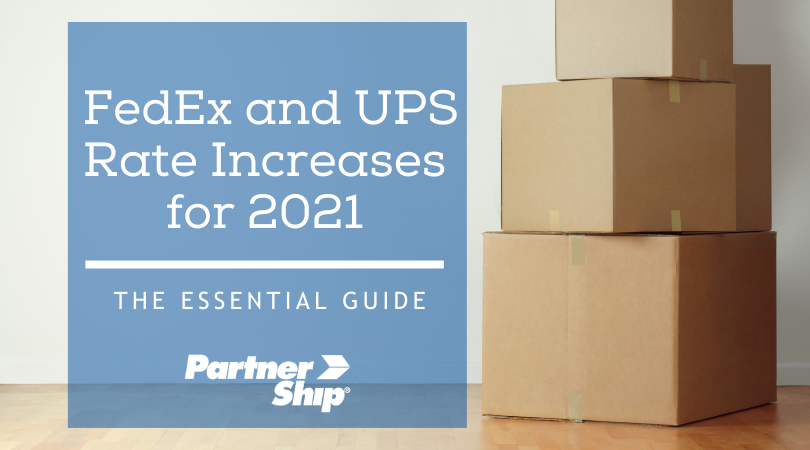the PartnerShip Connection blog
the PartnerShip Connection blog
the PartnerShip Connection blog
the PartnerShip Connection blog
the PartnerShip Connection blog
-
5 Ridiculously Easy Ways to Reduce Your Shipping Costs
12/21/2020 — Jen Deming
In a time where managing business operating expenses is extra important, one of the first places you should look is reducing shipping costs. But analyzing your small package shipping for areas of improvement can be a time-intensive, detail-oriented process. Not everyone has the time to audit invoices and compare rates. For those who want to get the job done quickly and easily, you’re in luck: there are five quick small pack hacks that smart shippers can easily implement to help reduce costs.
- Obtain discounts with carriers
Lots of shippers don’t realize that the pricing structure you are currently using with your carrier may be negotiable, and there are different types of discounts that your account may receive. FedEx and UPS often offer discounts for new accounts when created online, but shippers beware: these discounts are usually temporary, and your pricing may fluctuate based on terms and conditions. You may lose the discounts entirely if you aren’t meeting shipping minimums and your pricing is subject to change at any time.The more you ship, the better the discounts you’re likely to receive directly from FedEx or UPS. However, even if you have a lower shipping volume, there are still ways for you to obtain discounts. If your business belongs to a trade association or a local chamber, you may have access to discounted rates through your membership. PartnerShip manages over 130 association shipping programs that offer FedEx discounts. If you’re a member of an industry group, look into your member benefits or reach out to our team to find out if you’re eligible.
Take advantage of free packaging
The packaging and supplies you need to properly contain your shipments are important, but can be costly. However that doesn’t mean you should skimp on new materials or reuse old packaging – doing so can compromise the integrity of your shipment and increase the risk of damage. The good news is, some carriers offer free shipping supplies to help ensure your package is secure. Both UPS and FedEx offer free packaging supplies for customers that you can order online and have delivered, free of charge. With free envelopes, packing tubes, boxes, and poly bags, you can be sure your small package shipment will travel safely to its final destination, all while creating some space in your shipping budget.
Make the most of Multiweight and Hundredweight options
From insurance plans to your cable bill, everyone knows you can save money from bundling. That same principal can also apply to your shipping. Both FedEx and UPS offer options for customers who are shipping multiple packages to the same location that can help you save money versus the rates you would pay if they’re considered individual packages. For businesses shipping frequently to the same locations, FedEx multiweight pricing is an efficient and cost-effective service option. UPS has a similar program called UPS Hundredweight.
There is a catch for shippers interested in these options — it isn’t available to just any business. FedEx Multiweight and UPS Hundredweight must be negotiated into your contract, or offered as a part of comprehensive shipping program, like the association programs managed by PartnerShip.
Avoid dimensional weight pricing
To combat the increase in bulky packages entering their systems, FedEx and UPS have implemented dimensional (DIM) weight pricing. With DIM weight pricing, cost is calculated based on package volume, rather than weight. The higher the volume, the more space it takes up in delivery vehicles, which means there is less room for other packages. If a package isn’t particularly heavy but is taking up a lot of space, that’s costly for the carriers.
After calculating your DIM weight, measure the result against your package’s actual weight; the greater of the two will become your billable weight. The best way that you can offset volume-based pricing is to take a hard look at your current packaging procedures. Unused space is a cost-conscious shipper’s worst enemy, so don’t use a package that’s oversized for the product inside and consolidate your orders when possible to ensure you’re not wasting space.
Take control of inbound shipping
Another way to save on small package shipping is by taking control of your inbound shipping procedures. It’s common practice for many businesses to allow their inbound small package orders to be arranged by the vendor. But often times that leads to higher order costs for you. By instructing your vendor to ship through your account, you can reduce your costs through a few simple steps:
- Review your vendor invoices to determine whether you have access to better pricing through your FedEx/UPS account vs. your vendor’s account.
- Create routing instructions that include clear directions on which carrier, account, and service to use for your shipments.
- Ensure vendor compliance by providing your routing instructions to your vendors and regularly reviewing your invoices for accurate pricing.
While taking an in-depth look at how to minimize operating expenses can be time-consuming, these small package hacks give you a few quick ways to ship smarter. For more ways to save, PartnerShip can help.
It’s even more important to cut costs where you can, as FedEx and UPS rates are on the rise. Our free guide will help you easily identify the highest rate increases so you can more easily manage your budget.

Click to read more... - Obtain discounts with carriers
-
The Essential Guide to the 2021 FedEx and UPS Rate Increases
12/08/2020 — Leah Palnik

It’s been a wild and unpredictable year, but there’s one thing you can count on as we head into 2021 – the annual FedEx and UPS rate increases. For the fourth year in a row, both carriers announced an average increase of 4.9% for air and ground parcel services. The new rates for UPS will go into effect on December 27, while the new rates for FedEx will go into effect a week later on January 4.
How to budget your parcel costs for 2021
While it may be tempting to budget for a 4.9% increase, you have to dig a little deeper to uncover how much your costs will actually go up in 2021. The actual rate increases vary quite a bit depending on the service you use and your package characteristics.Both carriers have made the new rates for 2021 available:
You will also need to account for updates to FedEx and UPS surcharges. Common surcharges like Residential Delivery and Address Correction will be more expensive in the new year. But on top of that, FedEx and UPS have both made changes that could cause a package to incur a fee that it wouldn’t have in the past. For example, they both broadened the qualifications for their Additional Handling fee and have updated the list of zip codes for Delivery Area surcharges.
You can view a complete list of the changes that the carriers have each posted:
How to analyze the 2021 FedEx and UPS rate increases
While it’s imperative for you to be aware of the changes coming ahead in the new year, combing through every detail of the new rate charts is challenging and time-consuming. A good place to start is to identify the changes that will have the most significant impact on your budget. First, take a look at your shipments from the last year and identify trends for the services you typically use, your package characteristics, and zip codes. From there you can use the new report from PartnerShip, which highlights the areas with the highest increases and outlines the important changes.The state of the parcel industry
Aside from the general rate increases, it’s important to understand what’s happening within the parcel industry. Within the past several months, the coronavirus pandemic has brought on a great deal of logistical challenges. Carrier networks have been strained as they struggle to keep up with demand and deal with restrictions. As a result, both FedEx and UPS have instituted peak surcharges.Most notably, since the beginning of the pandemic FedEx and UPS have been applying peak surcharges to international shipments. Air cargo capacity has been limited which has disrupted the global supply chain and driven costs up.
Additionally, residential deliveries have increased substantially as more people are relying on online shopping. High-volume B2C shippers specifically have been ramping up their business. FedEx and UPS have responded to this increased demand by instituting peak surcharges. Instead of simply applying a surcharge on all residential shipments during the holiday season like they’ve done in the past, UPS and FedEx are applying it to those shippers with a large volume of packages or those who are experiencing a significant increase. That’s good news for many small businesses, but tough on those larger ecommerce retailers.
Even if these peak surcharges don’t apply to your business right now, it doesn’t mean that you’ll forever be immune. There are still a lot of unknowns related to the coronavirus pandemic and how it will continue to impact the supply chain. You will need to stay vigilant and keep up to date on announcements from FedEx and UPS.
What you can do to combat rising shipping costs
With everything the industry is experiencing right now, shippers don’t exactly hold the power. Add the general rate increases on top of that, and you may feel helpless against rising costs. However, there are things you can do to mitigate the damages. Download our guide to the 2021 FedEx and UPS rate increases to help identify the problem areas. Then contact PartnerShip to find out if you qualify for one of our discount shipping programs, and we'll help you ship smarter.
Click to read more...




